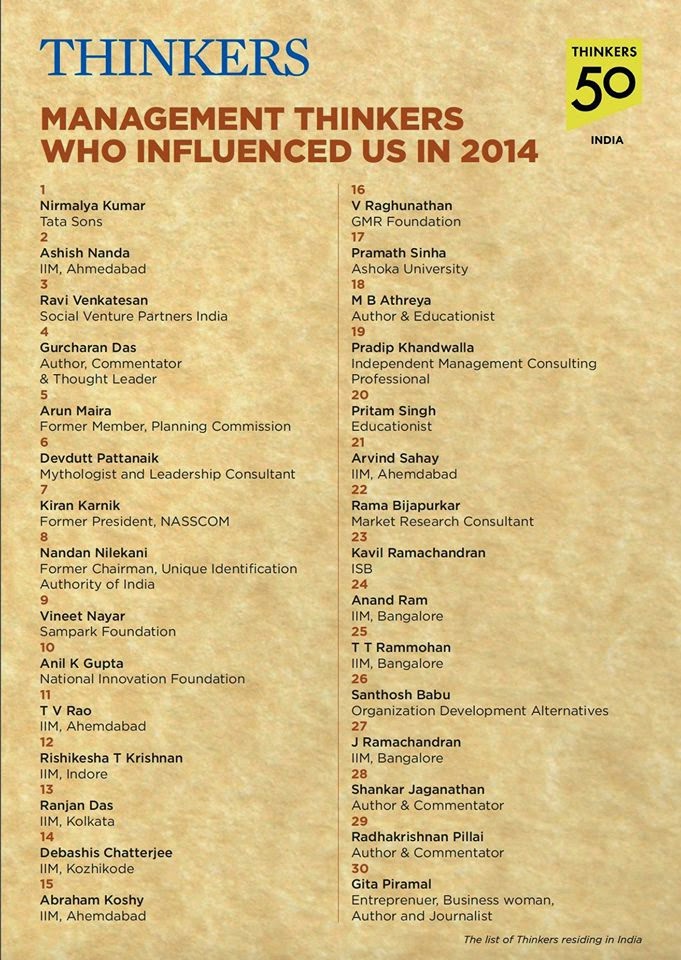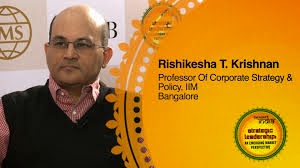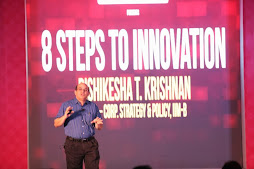My post on MOOCs evoked several interesting responses, and I therefore return to this theme. A key question is what really differentiates MOOCs from a number of earlier experiments on web-based education? Another important question is what is required to make the learning opportunity offered by MOOCs more effective?
To answer these questions, I’ll start by looking at some of IIMB’s experiences in distance learning, and then return to the MOOC theme.
The IIMB Experience in Expanding Reach
Our existing academic programmes at IIM Bangalore (and most other institutions of advanced higher learning in India) are classroom-based and limited by physical constraints such as classroom capacity or pedagogical constraints (its difficult to conduct a case discussion effectively in a very large class).For long, one of our dreams has been to reach out effectively to larger audiences, but without diluting the quality of instruction.
In the last decade, we have tried out different experiments with varying degrees of success. From a pedagogic standpoint, the most “successful” experiment was a satellite classroom that we created in Chennai. This had a two-way video link with a classroom on campus in Bangalore, and we used an ISRO satellite to offer our Post Graduate Programme in Software Enterprise Management (PGSEM), a part-time MBA-equivalent course, to software professionals in Chennai. The students in the Chennai classroom got a classroom experience that was almost as good as being in the original classroom. Some classes were taught in the “opposite” direction – i.e. the physical class was held in Chennai, and the Bangalore students participated through video. The picture and sound quality were excellent, and the only issue was that the link would occasionally fail. Our colleague, Shankar Venkatagiri did a wonderful job in designing the system and making it work.
We have also used commercially available video-conferencing services such as those provided by Hughes and Reliance to create virtual classrooms for executive education programmes. In the latter, participants in multiple distant locations can attend the course by going to a local Reliance Webworld studio. This is again based on 2-way video technology. It is supplemented by the participants attending a part of the programme face-to-face on campus. Though this is conceptually similar to what we did in the PGSEM, the feedback here has been mixed. I sometimes think this is because the distant participants feel that the in-class participants are getting a better classroom experience.
However, these efforts resulted in just a marginal increase in our reach. None of them really enlarged the reach by an order of magnitude or more.
[Before all this, about a decade ago, we also tried to create our own web-based management education programme. That didn’t work out well. Faculty did not understand the medium (the web) well and struggled to adapt their content to the web. Our content development partner did not understand our domain well enough to convert our content into learner-friendly lessons. We gave up the effort after creating a few of the modules.]
New Technologies, New Options
With the improvement in video-streaming technologies, and the higher bandwidth available to most urban consumers, there is no longer a necessity to create separate web content, or to use dedicated communication channels to beam videos. Instead, videos can be used through a publicly-available medium like Youtube. Globally, the Khan Academy is a great example of this, and it has become very popular for providing engaging lessons for school and undergraduate college students. Within India, a collaborative effort of the IITs, mptel, provides video-based lessons on a broad variety of engineering subjects.
However, education is not just about having good access to professors through video. The learning process needs interaction and testing. So, even though the Massively Open Online Courses that I wrote about in my previous blog all use videos extensively, they do much more than that.
As Amit Kapoor wrote in response to my earlier blog, an MOOC is not as simple as video taping a traditional class and putting it online. To be effective, it has to include:
1. Awesome Facilitation - facilitation for learning and not a dry lecture mode!
2. Interesting and Interactive Content - Short videos + quiz + real-time assignments is how it is done at Udacity.
3. Engaged and Active Community - You need to create a community around the course. The course community is very active in Udacity through wiki and discussion forum - and good MOOCs provide a medium to enable this important peer-to-peer learning mode
4. Scalable and Responsive Context - The technology should be scalable.
The better MOOCs have a research-based learning philosophy that they embed in their offerings. For example, Coursera uses interactive exercises as they believe these enhance learning. Within their videos, at frequent intervals, the video stops, and students are asked to answer a simple question. This keeps students focused on the learning process. Coursera cites research that shows that even simple retrieval questions have pedagogical value. The Coursera platform often gives immediate feedback on a concept the student did not understand. Following the philosophy of mastery learning, they sometimes provide randomized versions of the same assignment, so that a student can re-study and re-attempt the homework. They cite research again to show that this improves learning outcomes by one standard deviation.
There is, of course, a technology angle to this as well. As Vijay Kumar Ivaturi, co-founder India Innovation Labs and ex-CTO, Wipro Technologies, wrote to me:
• High end platforms provide shared white board interaction across class rooms on net ( Single Instructor Multiple Classrooms model) and this is where it gets complicated. It is not very easy to provide two way HD video based white board interaction without doing some magic at a IP layer. Most of them demand leased line of 2MBPS for such an experience in HD Video. ( e.g. Elucido Networks)
• There are other solutions which provide an acceptable experience level on standard 100kbps throughput level without white board interaction. This is more towards Real time class over network and a video on demand library for later viewing by students. ( e.g. Aurus Networks which won Microsoft business challenge this year)
More difficult for Qualitative Subjects
Online learning has so far worked well for skills and for subjects that have a strong foundation and structure like Mathematics. It’s much more difficult to provide interactive learning opportunities on topics where questions don’t necessarily have a unique correct answer. This is a challenge we will have to face if we want to use online learning models such as MOOCs to teach the softer aspects of management.
Going Forward
So far, on-line learning and MOOCs have been used primarily as a complement to formal education programmes or for adult/non-formal learners seeking to gain additional knowledge for themselves. Where MOOCs are used in formal education, it’s often through a complex process (see figure below).
In India, we need to move much more aggressively to use MOOCs to offer formal education programmes. That’s imperative if we want to enhance access, which is clearly an important priority.
As is well known, many challenges exist. As Vinay Tamboli wrote to me, there is a significant last mile challenge i.e.
1. Bandwidth availability in towns
2. Infrastructure (PC / device , instructor / helper, assembly place)
But there are some interesting possible solutions as well. Vinay Tamboli suggests that:
One of the solutions could be to build learning centers similar to book libraries at various locations. The library would have books, table, chairs, lights, etc.; these centers will have PC / device, large screen, satellite dish connections, sitting arrangements, helper etc.
Another option could be to involve companies like Tata who have satellite TV service, open a dedicated education channel which will be based on MOOC.
Arun Rajamani Sivaramakrishnan points to some other challenges:
1. Cost and availability of devices, PC’s etc in the rural and semi-urban set up
2. Availability of content in local languages– cost and complexity of managing this.
3. Continuing need to have an instructor to help translate
A lot of exciting challenges, but tremendous scope for innovation!
To answer these questions, I’ll start by looking at some of IIMB’s experiences in distance learning, and then return to the MOOC theme.
The IIMB Experience in Expanding Reach
Our existing academic programmes at IIM Bangalore (and most other institutions of advanced higher learning in India) are classroom-based and limited by physical constraints such as classroom capacity or pedagogical constraints (its difficult to conduct a case discussion effectively in a very large class).For long, one of our dreams has been to reach out effectively to larger audiences, but without diluting the quality of instruction.
In the last decade, we have tried out different experiments with varying degrees of success. From a pedagogic standpoint, the most “successful” experiment was a satellite classroom that we created in Chennai. This had a two-way video link with a classroom on campus in Bangalore, and we used an ISRO satellite to offer our Post Graduate Programme in Software Enterprise Management (PGSEM), a part-time MBA-equivalent course, to software professionals in Chennai. The students in the Chennai classroom got a classroom experience that was almost as good as being in the original classroom. Some classes were taught in the “opposite” direction – i.e. the physical class was held in Chennai, and the Bangalore students participated through video. The picture and sound quality were excellent, and the only issue was that the link would occasionally fail. Our colleague, Shankar Venkatagiri did a wonderful job in designing the system and making it work.
We have also used commercially available video-conferencing services such as those provided by Hughes and Reliance to create virtual classrooms for executive education programmes. In the latter, participants in multiple distant locations can attend the course by going to a local Reliance Webworld studio. This is again based on 2-way video technology. It is supplemented by the participants attending a part of the programme face-to-face on campus. Though this is conceptually similar to what we did in the PGSEM, the feedback here has been mixed. I sometimes think this is because the distant participants feel that the in-class participants are getting a better classroom experience.
However, these efforts resulted in just a marginal increase in our reach. None of them really enlarged the reach by an order of magnitude or more.
[Before all this, about a decade ago, we also tried to create our own web-based management education programme. That didn’t work out well. Faculty did not understand the medium (the web) well and struggled to adapt their content to the web. Our content development partner did not understand our domain well enough to convert our content into learner-friendly lessons. We gave up the effort after creating a few of the modules.]
New Technologies, New Options
With the improvement in video-streaming technologies, and the higher bandwidth available to most urban consumers, there is no longer a necessity to create separate web content, or to use dedicated communication channels to beam videos. Instead, videos can be used through a publicly-available medium like Youtube. Globally, the Khan Academy is a great example of this, and it has become very popular for providing engaging lessons for school and undergraduate college students. Within India, a collaborative effort of the IITs, mptel, provides video-based lessons on a broad variety of engineering subjects.
However, education is not just about having good access to professors through video. The learning process needs interaction and testing. So, even though the Massively Open Online Courses that I wrote about in my previous blog all use videos extensively, they do much more than that.
As Amit Kapoor wrote in response to my earlier blog, an MOOC is not as simple as video taping a traditional class and putting it online. To be effective, it has to include:
1. Awesome Facilitation - facilitation for learning and not a dry lecture mode!
2. Interesting and Interactive Content - Short videos + quiz + real-time assignments is how it is done at Udacity.
3. Engaged and Active Community - You need to create a community around the course. The course community is very active in Udacity through wiki and discussion forum - and good MOOCs provide a medium to enable this important peer-to-peer learning mode
4. Scalable and Responsive Context - The technology should be scalable.
The better MOOCs have a research-based learning philosophy that they embed in their offerings. For example, Coursera uses interactive exercises as they believe these enhance learning. Within their videos, at frequent intervals, the video stops, and students are asked to answer a simple question. This keeps students focused on the learning process. Coursera cites research that shows that even simple retrieval questions have pedagogical value. The Coursera platform often gives immediate feedback on a concept the student did not understand. Following the philosophy of mastery learning, they sometimes provide randomized versions of the same assignment, so that a student can re-study and re-attempt the homework. They cite research again to show that this improves learning outcomes by one standard deviation.
There is, of course, a technology angle to this as well. As Vijay Kumar Ivaturi, co-founder India Innovation Labs and ex-CTO, Wipro Technologies, wrote to me:
• High end platforms provide shared white board interaction across class rooms on net ( Single Instructor Multiple Classrooms model) and this is where it gets complicated. It is not very easy to provide two way HD video based white board interaction without doing some magic at a IP layer. Most of them demand leased line of 2MBPS for such an experience in HD Video. ( e.g. Elucido Networks)
• There are other solutions which provide an acceptable experience level on standard 100kbps throughput level without white board interaction. This is more towards Real time class over network and a video on demand library for later viewing by students. ( e.g. Aurus Networks which won Microsoft business challenge this year)
More difficult for Qualitative Subjects
Online learning has so far worked well for skills and for subjects that have a strong foundation and structure like Mathematics. It’s much more difficult to provide interactive learning opportunities on topics where questions don’t necessarily have a unique correct answer. This is a challenge we will have to face if we want to use online learning models such as MOOCs to teach the softer aspects of management.
Going Forward
So far, on-line learning and MOOCs have been used primarily as a complement to formal education programmes or for adult/non-formal learners seeking to gain additional knowledge for themselves. Where MOOCs are used in formal education, it’s often through a complex process (see figure below).
In India, we need to move much more aggressively to use MOOCs to offer formal education programmes. That’s imperative if we want to enhance access, which is clearly an important priority.
As is well known, many challenges exist. As Vinay Tamboli wrote to me, there is a significant last mile challenge i.e.
1. Bandwidth availability in towns
2. Infrastructure (PC / device , instructor / helper, assembly place)
But there are some interesting possible solutions as well. Vinay Tamboli suggests that:
One of the solutions could be to build learning centers similar to book libraries at various locations. The library would have books, table, chairs, lights, etc.; these centers will have PC / device, large screen, satellite dish connections, sitting arrangements, helper etc.
Another option could be to involve companies like Tata who have satellite TV service, open a dedicated education channel which will be based on MOOC.
Arun Rajamani Sivaramakrishnan points to some other challenges:
1. Cost and availability of devices, PC’s etc in the rural and semi-urban set up
2. Availability of content in local languages– cost and complexity of managing this.
3. Continuing need to have an instructor to help translate
A lot of exciting challenges, but tremendous scope for innovation!

















Great article. I will have my first coursera experience for a statistics course starting from Sept 1. It was recommended by my classmate who took it along with his son from Madgaon, Goa. Family members (e.g. father and son) taking courses together creates interesting learning opportunities especially in the Indian context.
ReplyDeleteI show the same video content to different category of participants e.g. age (21-55), English-savviness, Shop-floor vs Manager. I realize that it helps to identify places where video would be paused and either it can be summarized in, say Hindi and/or a few questions can be asked on the content. Summary / translation / pause locations is information complementary to video content. If this is indeed true, then we can re-use existing / rapidly expanding video content by developing this meta-information targeting specific type of students.